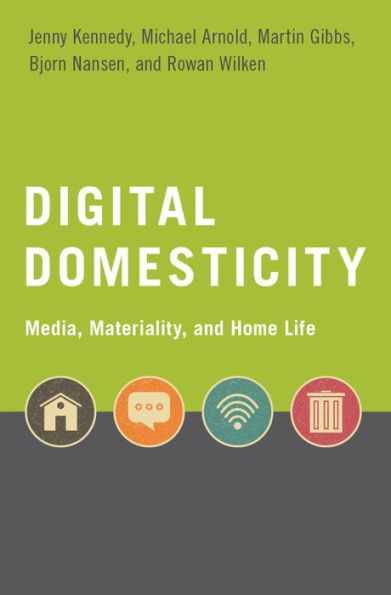At the turn of the twenty-first century, typical households were equipped with a landline telephone, a desktop computer connected to a dial-up modem, and a shared television set. Television, radio and newspapers were the dominant mass media. Today, homes are now network hubs for all manner of digital technologies, from mobile devices littering lounge rooms to Bluetooth toothbrushes in bathrooms--and tomorrow, these too will be replaced with objects once inconceivable. Tracing the origins of these digital developments, Jenny Kennedy, Michael Arnold, Martin Gibbs, Bjorn Nansen, and Rowan Wilken advance media domestication research through an ecology-based approach to the abundance and materiality of media in the home. The book locates digital domesticity through phases of adoption and dwelling, to management and housekeeping, to obsolescence and disposal. The authors synthesize household interviews, technology tours, remote data collection via mobile applications, and more to offer readers groundbreaking insight into domestic media consumption. Chapters use original case studies to empirically trace the adoption, use, and disposal of technology by individuals and families within their homes. The book unearths social and material accounts of media technologies, offering insight into family negotiations regarding technology usage in such a way that puts technology in the context of recent developments of digital infrastructure, devices, and software--all of which are now woven into the domestic fabric of the modern household.
1136839823
Digital Domesticity: Media, Materiality, and Home Life
At the turn of the twenty-first century, typical households were equipped with a landline telephone, a desktop computer connected to a dial-up modem, and a shared television set. Television, radio and newspapers were the dominant mass media. Today, homes are now network hubs for all manner of digital technologies, from mobile devices littering lounge rooms to Bluetooth toothbrushes in bathrooms--and tomorrow, these too will be replaced with objects once inconceivable. Tracing the origins of these digital developments, Jenny Kennedy, Michael Arnold, Martin Gibbs, Bjorn Nansen, and Rowan Wilken advance media domestication research through an ecology-based approach to the abundance and materiality of media in the home. The book locates digital domesticity through phases of adoption and dwelling, to management and housekeeping, to obsolescence and disposal. The authors synthesize household interviews, technology tours, remote data collection via mobile applications, and more to offer readers groundbreaking insight into domestic media consumption. Chapters use original case studies to empirically trace the adoption, use, and disposal of technology by individuals and families within their homes. The book unearths social and material accounts of media technologies, offering insight into family negotiations regarding technology usage in such a way that puts technology in the context of recent developments of digital infrastructure, devices, and software--all of which are now woven into the domestic fabric of the modern household.
31.49
In Stock
5
1

Digital Domesticity: Media, Materiality, and Home Life
240
Digital Domesticity: Media, Materiality, and Home Life
240Related collections and offers
31.49
In Stock

Product Details
| ISBN-13: | 9780190905811 |
|---|---|
| Publisher: | Oxford University Press |
| Publication date: | 05/13/2020 |
| Sold by: | Barnes & Noble |
| Format: | eBook |
| Pages: | 240 |
| File size: | 9 MB |
About the Author
From the B&N Reads Blog
